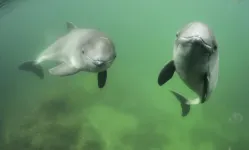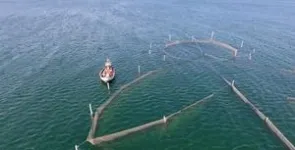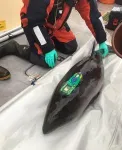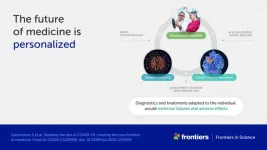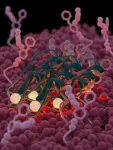(Press-News.org) Summer is coming and that means more boats in the sea. Danish coastal waters are especially cluttered with small boats in the summertime. Locals water skiing, going fishing or just riding around the beautiful bays and fjords.
In general people relax and have a good time on the water, but that is unfortunately not the case for the harbor porpoise.
The more motor boats speeding noisily around, the more they are disturbed. And that can be a big problem for the animals.
Because the harbor porpoise is a relatively large animal that feeds on small fish it needs to spend a lot of time hunting. New research shows that it spends around 60 percent of its time on the hunt, but if noise from the motor boats disturb them and makes them quit the pursuit of fish this could have negative implications for the survival of these animals, explains postdoc Laia Rojano Doñate from the Department of Ecoscience at Aarhus University. She is one of the researchers behind the new results.
- Harbor porpoises spend a lot of energy in a day. Not because they spend it hunting for fish, but because they need it to stay warm.
- Because they live in cold waters, it takes a lot of energy for them to thermoregulate. That’s why it’s a big problem if they are disturbed by motor boats and stop eating, she says.
Almost never alone
Over the years Laia Rojano Doñate and her colleagues have put tracking devices on several harbor porpoises to learn about their behavior and how they may be disturbed by humans in boats.
I 2018 they investigated how often the harbor porpoises are near noise from boats – and the number surprised her.
- We could hear the frequencies of motor boats near the animals 80 percent of the time. That is a huge problem, when they need to hunt 60 percent of the time, she says.
The tracking device not only listens to everything going on around the harbor porpoises, it also measures the depth at which the animals dive and has a GPS tracker on. The data from 2018 showed clearly that some animals suddenly stopped hunting when motor boats approached.
- When hunting for fish they make a buzz sound just before they catch the prey. The sound helps them navigate in the dark waters deep below. But when motor boats were around they sometimes stopped buzzing.
- That may not be a problem if it happens once or twice a day. But if it’s a constant nuisance to the animals they don’t catch the fish they need. In the long run that will kill them.
Hunts like a grazing cow
The harbor porpoise requires a lot of energy to stay warm in the cold waters. But because it feeds on small fish it needs to catch around 2000 fish a day and that requires hunting most of the time. Kind of like a cow grazing and eating most of the day.
Like cows foraging is very cost efficient for the harbor porpoise.
Researchers have studied the animal extensively - both in captivity and in the wild. That’s how they know exactly how much energy it spends doing different tasks.
For example, it breathes around 4000 times a day. Each breath burns around 5 kilojoules. Do the math and that amounts to 20 megajoules of energy required to get through a single day.
By injecting water labeled with stable isotopes into the blood of captive harbor porpoises – isotopes that disappear as oxygen in the blood is burned during cellular respiration – the researchers have tested that these numbers are correct. They now have a formula for calculating the energy expenditure of harbor porpoises of different sizes.
Harbor porpoises are disappearing fast
For many years researchers thought that the harbor porpoises in Kattegat were fine. The population was stable around 40.000 individuals and pollution, overfishing and getting caught in the fishing nets didn’t seem to make an impact.
But now it seems as though a tipping point has been reached and the population is disappearing fast. In the latest count only 14.000 harbor porpoises were left.
One explanation for the dwindling population is that there are fewer and smaller fish in the sea. This forces the harbor porpoises to spend more time on the hunt, which again makes them more vulnerable to disturbances from boats, Laia Rojano Doñate explains.
- Getting disturbed by boats is not the only cause. More pollution and getting caught in the fishing nets are also part of the explanation of why harbor porpoises are disappearing fast.
- Last but not least, the grey seal population is growing. Grey seals hunt the harbor porpoises and eat them. So it’s not easy being a harbor porpoise these days.
Lives close to the coast
Even though the harbor porpoise is part of the whale family, it spends a lot of time in coastal water. At least that is the case for the population living in Kattegat.
The porpoises in the Kattegat hunt fish in shallow waters, but that is also where most of the recreational motor boats are. And that is a problem, Laia Rojano Doñate explains.
- We might not even notice it, but when we venture out on the sea on a sunny summer day, we might be disturbing a lot of animals. If we are to do something about this problem, we have to change our habits.
Not only would zones where motor boats are prohibited help the animals, but a lot less could make a difference.
- When out on the water it would help the animals if people didn’t speed up and slow down or went around haphazardly. I know that’s part of the fun, but not for the harbor porpoises.
END
Constantly on the hunt for food: Harbor porpoises more vulnerable than previously thought to the disturbances from humans
The small whales spend more than 60 percent of their day hunting small fish to stay warm in the cold waters. New research shows that harbor porpoises spend little energy on this hunting strategy, but that it makes them vulnerable to human disturbance
2024-05-23
ELSE PRESS RELEASES FROM THIS DATE:
Producing novel liquid crystals by stacking antiaromatic units
2024-05-23
In organic chemistry, π-stacking systems are supramolecular structures that arise due to the dispersion force, a type of intermolecular noncovalent interaction. They are a common occurrence in nature; the stabilized structure of DNA is a very prominent example of a π-stacking system, and so are the arrangement of amino acids in certain proteins. Interestingly, π-stacking can be leveraged in the design of materials with useful electronic and optical properties. These include organic semiconductors of various kinds, as well as conjugated polymers for sensing and biomedical applications.
Thus far, a good portion of technologically relevant π-stacking system has been limited ...
First pictures from Euclid satellite reveal billions of orphan stars
2024-05-23
The first scientific pictures from the Euclid satellite mission have revealed more than 1,500 billion orphan stars scattered throughout the Perseus cluster of galaxies.
Led by astronomers from the University of Nottingham, this discovery sheds light on the origins of these celestial wanderers.
The Perseus cluster, located 240 million light-years away from Earth, is one of the Universe's most massive structures, boasting thousands of galaxies. However, amidst this cosmic ensemble, the Euclid satellite captured faint ghostly light - the orphan stars - drifting between the cluster's galaxies.
Stars naturally form within galaxies, so the presence of orphan ...
VIDEO: Surrey astrophysicists explore new galaxies and streams of stars using new data from Euclid space telescope
2024-05-23
As the European Space Agency publishes the first findings from its Euclid space telescope, scientists from the University of Surrey are celebrating fresh insights from the data.
Dr Denis Erkal, Associate Professor of Astrophysics at the University of Surrey, studies how the gravity of the Milky Way pulls clusters of stars apart, creating streams of stars trailing across the galaxy.
Now, his model for how this happens (video HERE) has been confirmed by data from Euclid.
Dr Erkal said:
“For a long time, my modelling ...
Scientists reveal first data from Euclid telescope offering snapshot of cosmic history
2024-05-23
Scientists have released the first set of scientific data captured with the Euclid telescope, showing an exciting glimpse of the Universe’s distant past.
The telescope, launched in July 2023, is part of the Dark Energy Satellite Mission, which aims to map the dark Universe.
Led by the European Space Agency in collaboration with The Euclid Consortium - which includes astronomers at The University of Manchester in leadership positions – the mission seeks to unlock mysteries of dark matter and dark energy and reveal how and why the Universe looks as it does today.
Early observations, described in a series ...
Big data, AI, and personalized medicine: scientists reveal playbook aiming to revolutionize healthcare
2024-05-23
What should the medicine of the future look like? A team of scientists writing in Frontiers in Science lays out a bold vision for precision approaches to understanding, preventing, and treating diseases, driven by revolutionary technologies and new interdisciplinary collaborations between researchers and other health sector professionals. The internationally renowned authors – led by Prof Michel Goldman, recipient of the Blaise Pascal Medal 2024 for his exceptional contributions to immunology and healthcare innovation, and leading microbiologist Prof Philippe Sansonetti from the Institut Pasteur and Collège ...
First ever survey of A&E triage nurses highlights problems with a lack of training, low staffing, high stress and overflowing departments
2024-05-23
Peer-reviewed - survey - people
Nurses who assess patients at emergency departments would like more training and say their decisions can be negatively impacted by the high pressures of their work.
Researchers at the University of East Anglia conducted the first ever UK survey of triage nurses to discover the background, training and decision-making processes of this role in emergency departments.
Lead author Hugh Gorick, a PhD researcher at UEA’s School of Health Sciences who also works as an assistant practitioner in an NHS hospital’s Acute Medical Unit, said: “More than 24 million patients present to emergency departments ...
The global clean water crisis looms large
2024-05-23
Water scarcity will intensify with climate and socioeconomic change, disproportionately impacting populations located in the Global South. So concludes a new Utrecht University article published in Nature Climate Change on 23 May 2024, which used a state-of-the-art global water quantity and quality model to estimate clean water scarcity until the end of the century.
Humans require clean water for drinking and sanitation purposes, but also for the production of food, energy and manufactured goods. As communities and policymakers grapple with water scarcity issues on the ground, researchers ...
Antibiotic ‘Velcro’ gives bacteria a sticky situation
2024-05-23
A small antibiotic called plectasin uses an innovative mechanism to kill bacteria. By assembling into large structures, plectasin latches onto its target on the bacterial cell surface comparable to how both sides of Velcro form a bond. A research team, led by structural biologist Markus Weingarth and biochemist Eefjan Breukink at Utrecht University, mapped how the Velcro-structure is formed. Their discovery, published in the scientific journal Nature Microbiology, unveils a new approach that could have broad implications for the development of antibiotics to ...
City of Hope researchers to present investigational treatments for colorectal, kidney and blood cancers at 2024 American Society of Clinical Oncology (ASCO) Annual Meeting
2024-05-23
LOS ANGELES — World-renowned physicians and researchers from City of Hope®, one of the largest cancer research and treatment organizations in the United States, will present new data and offer expert perspectives on leading-edge cancer research and treatments in development at the 2024 ASCO Annual Meeting, which will take place in Chicago from May 31 to June 4. Highlights include the following:
2024 Best of ASCO® program: New data on mismatched unrelated donor peripheral blood stem cell transplantation
Late-breaking data on the phase 3 CodeBreaK 300 trial
Glofitamab monotherapy for patients ...
Bigger is better: male proboscis monkeys’ enhanced noses evolved to attract mates
2024-05-23
When it comes to the animal kingdom, bigger is better. Well, at least for proboscis monkeys, famously known for their long, large and droopy noses.
Researchers from The Australian National University (ANU) have provided a world-first explanation for why male proboscis monkeys have larger and “enhanced” nasal structures.
The researchers examined the bony nasal cavity inside the skulls of proboscis monkeys and found their large noses are more than just an eye sore and in fact offer several major benefits, especially when ...
LAST 30 PRESS RELEASES:
Numbers in our sights affect how we perceive space
SIMJ announces global collaborative book project in commemoration of its 75th anniversary
Air pollution exposure and birth weight
Obstructive sleep apnea risk and mental health conditions among older adults
How talking slows eye movements behind the wheel
The Ceramic Society of Japan’s Oxoate Ceramics Research Association launches new international book project
Heart-brain connection: international study reveals the role of the vagus nerve in keeping the heart young
Researchers identify Rb1 as a predictive biomarker for a new therapeutic strategy in some breast cancers
Survey reveals ethical gaps slowing AI adoption in pediatric surgery
Stimulant ADHD medications work differently than thought
AI overestimates how smart people are, according to HSE economists
HSE researchers create genome-wide map of quadruplexes
Scientists boost cell "powerhouses" to burn more calories
Automatic label checking: The missing step in making reliable medical AI
Low daily alcohol intake linked to 50% heightened mouth cancer risk in India
American Meteorological Society announces Rick Spinrad as 2026 President-Elect
Biomass-based carbon capture spotlighted in newly released global climate webinar recording
Illuminating invisible nano pollutants: advanced bioimaging tracks the full journey of emerging nanoscale contaminants in living systems
How does age affect recovery from spinal cord injury?
Novel AI tool offers prognosis for patients with head and neck cancer
Fathers’ microplastic exposure tied to their children’s metabolic problems
Research validates laboratory model for studying high-grade serous ovarian cancer
SIR 2026 delivers transformative breakthroughs in minimally invasive medicine to improve patient care
Stem Cell Reports most downloaded papers of 2025 highlight the breadth and impact of stem cell research
Oxford-led study estimates NHS spends around 3% of its primary and secondary care budget on the health impacts of heat and cold in England
A researcher’s long quest leads to a smart composite breakthrough
Urban wild bees act as “microbial sensors” of city health.
New study finds where you live affects recovery after a hip fracture
Forecasting the impact of fully automated vehicle adoption on US road traffic injuries
Alcohol-related hospitalizations from 2016 to 2022
[Press-News.org] Constantly on the hunt for food: Harbor porpoises more vulnerable than previously thought to the disturbances from humansThe small whales spend more than 60 percent of their day hunting small fish to stay warm in the cold waters. New research shows that harbor porpoises spend little energy on this hunting strategy, but that it makes them vulnerable to human disturbance
